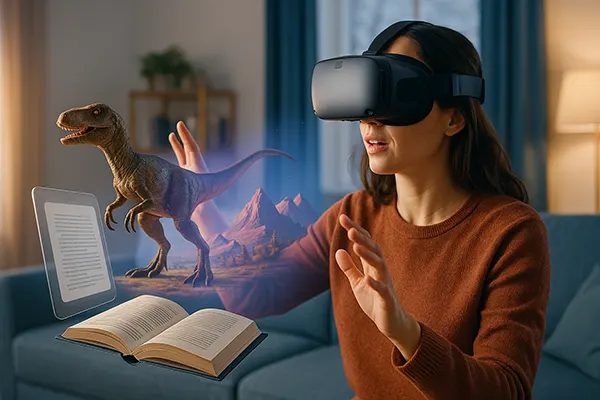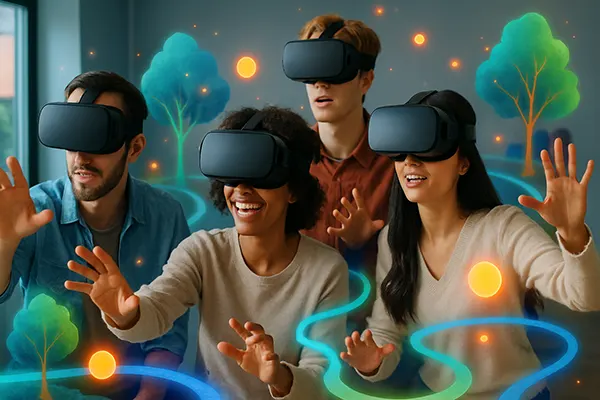
Interactive Copywriting: AR, VR and Stories Readers Can Influence
Interactive copywriting in 2025 is no longer limited to static words on a page. With augmented reality (AR) and virtual reality (VR) becoming more accessible, content creators are experimenting with immersive narratives where the reader is not just a passive observer, but an active participant. This shift is reshaping how brands communicate, how audiences engage, and how stories evolve in real time. By blending technology with storytelling, writers can now craft experiences that adapt to individual choices, making each reader’s journey unique. The integration of interactivity into copy demands both creativity and technical understanding to ensure stories remain coherent while offering multiple narrative paths.
The Evolution of Interactive Storytelling
Over the past decade, storytelling has transformed from linear scripts to multi-threaded narratives. In AR and VR environments, users can explore different perspectives, uncover hidden details, and decide how the plot unfolds. This level of interaction enhances emotional connection and creates a stronger sense of involvement. The shift has been driven by advances in hardware like lightweight VR headsets and AR-enabled mobile devices, as well as software platforms that simplify interactive content production. Brands now use these tools not only for entertainment but also for training, education, and marketing, ensuring messages are both memorable and measurable.
The appeal of interactive storytelling lies in its adaptability. Unlike traditional formats, these experiences can be tailored in real time based on user choices. This could mean a reader selecting which product feature to explore in a marketing narrative, or a trainee making decisions in a simulated crisis scenario. As AI-driven tools become more sophisticated, the ability to personalise experiences without losing narrative integrity will define the next generation of interactive copywriting.
However, the transition to interactive formats also presents challenges. Writers must consider branching dialogues, alternative endings, and varying levels of user engagement. Maintaining a consistent tone and ensuring factual accuracy across all possible paths requires rigorous planning and content mapping. This demands a hybrid skill set that blends traditional writing expertise with interactive media design principles.
Key Benefits for Brands and Audiences
For brands, interactive storytelling powered by AR and VR offers unparalleled engagement metrics. Instead of passively scrolling, audiences actively participate, which increases retention and recall rates. Campaigns built around interactivity can generate valuable behavioural data, helping refine both messaging and product offerings. The ability to measure which narrative paths users prefer gives marketers insights that static formats cannot provide.
From an audience perspective, these experiences feel more personalised and relevant. When users influence the outcome, they develop a stronger emotional investment in the content. This creates a sense of agency, encouraging deeper exploration and repeat engagement. The connection between brand and audience becomes more conversational, as users feel they are part of the story rather than passive recipients.
In educational and training contexts, interactive narratives enable active learning. For example, medical students can practise decision-making in simulated emergency situations using VR scenarios, while retail staff can train on customer service skills through AR roleplay. These formats not only convey information but also allow learners to apply knowledge immediately within a realistic environment.
AR and VR Tools for Copywriters
In 2025, the range of AR and VR tools available to copywriters has expanded dramatically. No longer restricted to specialised developers, many no-code and low-code platforms now allow writers to design interactive elements themselves. Tools like Unity’s visual scripting, Adobe Aero, and WebXR frameworks have made it possible to integrate immersive elements directly into brand narratives. Copywriters can collaborate with designers to create scripts that trigger animations, display interactive 3D models, or guide users through spatial experiences.
For AR, mobile compatibility remains key. Campaigns can use location-based triggers, allowing readers to access story elements only in specific places. This is particularly effective for tourism, retail, and event marketing. For VR, advances in standalone headsets mean users can engage without needing expensive PCs, making high-quality immersive experiences more widely accessible. Such accessibility is crucial for scaling interactive campaigns beyond niche audiences.
Importantly, effective AR and VR copywriting requires understanding how audiences navigate space and interact with visual elements. The positioning of text, timing of prompts, and integration of audio cues all influence user behaviour. Writers must think beyond the written word, crafting scripts that work seamlessly with visual, auditory, and tactile inputs to maintain immersion and coherence.
Designing Narratives that Adapt
One of the biggest shifts for copywriters working with AR and VR is designing adaptive narratives. These are stories that change based on user behaviour, location, or even biometric feedback. By incorporating decision points, writers can create branching paths that offer different outcomes, keeping users engaged over multiple sessions. This requires careful balance between freedom and structure to avoid confusion or narrative breakdown.
Writers must also consider pacing. In traditional copywriting, pacing is controlled entirely by the author, but in interactive formats, the audience can linger or skip ahead. This unpredictability means copy must work in modular segments, each capable of delivering value independently while still connecting to the broader storyline. Strong transitions are essential to ensure users can re-engage even after pausing the experience.
Accessibility remains a critical factor. AR and VR narratives must be inclusive for users with varying levels of technical comfort and physical ability. Providing multiple input options, clear navigation cues, and alternative formats for key content ensures no audience segment is excluded. This is especially important for public sector and educational applications where equal access is a legal requirement.

Future Trends in Interactive Copywriting
The next frontier for interactive copywriting lies in merging AR and VR with emerging technologies like generative AI and real-time translation. AI can dynamically generate story elements in response to user input, allowing for near-infinite narrative variations. Real-time translation ensures these experiences are globally accessible, enabling brands to reach wider audiences without losing the nuance of original scripts.
Another trend is the integration of haptic feedback, enabling users to feel physical sensations tied to narrative events. This adds an extra sensory dimension, deepening immersion and emotional impact. As wearable technology advances, writers may soon be scripting experiences where touch, temperature, and motion are as integral to the story as visuals and sound. These multi-sensory narratives could redefine what it means to “read” a story.
Finally, the convergence of interactive storytelling with the creator economy will see more independent writers producing AR and VR content without relying on large studios. As distribution platforms become more open, small teams and solo creators can publish immersive experiences directly to consumers, driving innovation through niche, highly personalised storytelling formats.
Preparing for the Interactive Future
Copywriters looking to excel in interactive formats should focus on building multidisciplinary skills. Understanding user experience (UX) principles, basic coding, and interactive media design will become as essential as strong writing fundamentals. Collaboration with developers, designers, and data analysts will ensure stories are not only engaging but also technically sound and measurable.
Writers should also stay informed about evolving hardware capabilities and software tools. Familiarity with headset specifications, mobile AR frameworks, and emerging distribution channels will allow them to design content optimised for current and future devices. Early adoption of new tools can give brands a competitive edge in delivering innovative experiences.
Above all, success in interactive copywriting depends on maintaining narrative integrity. No matter how advanced the technology, the story must remain at the heart of the experience. Writers who can balance creativity, technical execution, and audience empathy will be best positioned to shape the next chapter in storytelling.
